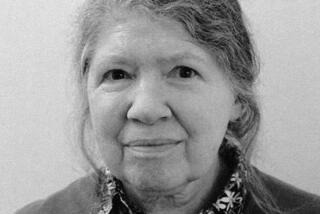Gone With the Windsors : WALLIS: The Novel <i> By Anne Edwards</i> ; <i> (William Morrow: $22; 489 pp.) </i>
- Share via
It’s embarrassing to admit, but I’ve always had a thing about royalty. Ever since I was a small child, I harbored a secret fantasy that someday, somehow, in some fantastically wealthy kingdom the powers-that-be would discover that I was the long-lost heir to the throne. “I guess I could give up free-lance writing,” I would stammer demurely as I was crowned with a modest tiara dripping with golf-ball-sized diamonds and emeralds.
Over the years, anticipating my coronation, I have read every book about royalty that I could find. It’s hard to find one I didn’t like. But the portentously titled “Wallis: The Novel” by Anne Edwards is not grist for even my voracious royal mill.
On the plus side, the book is meticulously researched and competently written in clear, simple prose. It reminds me of the Landmark Biographies I enjoyed as a child. The author follows the life of the future Duchess of Windsor from her childhood days as a poor relation to a pedigreed Baltimore family through two unfortunate marriages, a sojourn in war-torn China, a royal love affair, the abdication, and up to the most famous marriage of the century. I found it a little maddening that His Royal Highness doesn’t really enter the picture until Page 300 (of a 489-page book), but the story is never dull.
Still, a fictional biography of the Duchess of Windsor seems like a great idea. Thousands of pages already have been written chronicling the every twitch of Wallis Warfield Simpson, the Baltimore-born divorcee for whom King Edward VIII gave up the British throne in 1936. With new facts being in short supply, what better way to satisfy readers’ insatiable curiosity than to simply make things up?
And what a field seems to be open to imagination. For decades, the conventional wisdom has attributed Mrs. Simpson’s success with Edward VIII to sexual prowess. For example, in his 1981 biography “Duchess,” Stephen Birmingham speculated: “It had to be something Wallis was able to do in bed, something no other woman had been able to do, or tried to do, which made him feel more vital, more satisfied, more manly. . . . Some said, for example, that during Wallis’ mysterious two-year ‘China period,’ she had learned to perform exotic Oriental bits of sexual business--from the ‘sing-sing’ houses.”
But alas, “Wallis: The Novel” is tamer than a romance novel. This is about as hot as it gets: “They kissed again, clinging long. Arms entwined about each other’s waists, they walked up to the road where the car was waiting. They drove in stirring silence back to the villa. As they were about to enter, he took a narrow velvet case from his inside pocket and slipped it into her hand.
“ ‘Open this later,’ he said, adding softly. ‘Come to me in an hour.’
“ ‘No, David, this time you come to me,’ she replied.’ ”
But all that happens later is that she discovers a “superb diamond and emerald bracelet” in the velvet box.
Even for readers who aren’t secretly hoping for details along the lines of Catherine the Great and the stallion, “Wallis: The Novel” seems little more than a coloring book filling in the blanks between well-documented facts.
For instance, here is biographer Charles Higham’s (“The Duchess of Windsor: The Secret Life”) description of a scene that took place at Fort Belvedere, the Prince of Wales’ residence. Former mistress Thelma Furness returns from vacation to discover she has been replaced by Wallis. “The worst happened at dinner that night. The prince picked up a lettuce leaf with his fingers to nibble it. Wallis slapped his hand and told him brusquely to use a knife and fork in the future. He smiled sheepishly and blushed like a schoolboy. Thelma looked at Wallis, who answered her gaze with an icy triumphant stare.”
Here is the fictional version: “At dinner at the Fort that evening, Thelma could not help but notice how intimate Wallis was with the Prince and that they had their private little jokes. At one point, he picked up a leaf of his salad with his fingers. Wallis playfully slapped his hand. Thelma, aghast at such a lapse of decorum, caught Wallis’ eye and shook her head. Wallis, she thought, should know that, no matter how friendly the Prince appeared, such familiarity was not permitted, for his image of himself was always framed by the Royal three feathers.
“Wallis smiled blandly at her from her position to the Prince’s right. Then, suddenly, it was clear to Thelma. Wallis, of all people!”
The few fictional elements that do exist--a wealthy uncle who turns out to be more than her uncle, an encounter with spies in Peking--just seem to be in the book to make Wallis Warfield Simpson Windsor a sympathetic character--a feat that none of her numerous biographers has ever managed to accomplish. To gain the reader’s compassion, the author has had to gloss over such character flaws as rampant racism, Nazi sympathies, egregious snobbishness, callousness and cattiness.
Besides, the one good trait that the duchess had, at least in my opinion, was her devotion to her pug dogs, which reportedly sported mink and diamond-studded collars and were scented in Dior perfume. And there’s not a single pug in “Wallis: The Novel.” Still, if you’re in the mood for a happy-talking, superficial but accessible look at one of the most famous heroines in romantic history, then this is a book for you.
More to Read
Sign up for our Book Club newsletter
Get the latest news, events and more from the Los Angeles Times Book Club, and help us get L.A. reading and talking.
You may occasionally receive promotional content from the Los Angeles Times.








